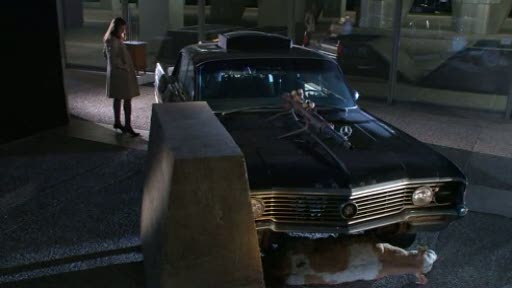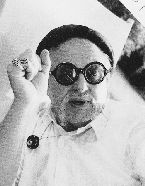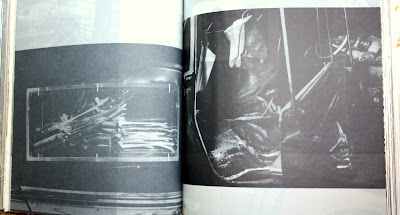SKL . auf dem Wege . auf der Suche. Bearb. v. Wolf Vostell u. Siegfried Gnichwitz. Hrsg .v. Karl Götze, Theo Drissen van der Lieck u. Werner Rudolf Vogt.
Wolf Vostell: "Mit(h)ropa"
Skulpturenmuseum Glaskasten Marl
 Dienstag, 08. Juni 2010, 23.10 - 23.15 Uhr
Dienstag, 08. Juni 2010, 23.10 - 23.15 Uhr
Ein Auto, festgefahren im Beton. Vor dem Reifen liegt das, was wir sonst gerne auf der Weide sehen. Oder als Steak auf dem Teller. Luxus-Stern und Schusswaffen, Gewalt und Machogehabe. Das Kalb ist ausgestopft, das Fahrzeug ein sportlicher Buik: Wir sind in den 70er Jahren, bei einem Happening von Wolf Vostell (1932-1998), der die Grenzen zwischen Kunst und Leben immer wieder neu ausgelotet hat.
Durch Kunst Arbeit und Alltag verändern
Diesmal geht es um Rindvieh und Männerarbeit. Und keine spektakuläre Kunstaktion ohne Publikum: Sehen und gesehen werden. Elektronische Überwachung und Selbstdarstellung zugleich. Im Kotflügel steckt ein Schlachtermesser. Ein absurder Zusammenprall. Allerdings: Schlachthöfe und Autohersteller produzieren nach den gleichen Prinzipien. Alles hängt mit allem zusammen: der Sportwagen, der Fernschreiber und die Nachrichten aus aller Welt.
Das Auto deklarierte Vostell zur wahnwitzigsten Skulptur des 20. Jahrhunderts. Sein multimedialer Schlitten "Mit(h)ropa", Abkürzung für "Mitteleuropa", entstand 1974 als Auftragsarbeit für eine der größten europäischen Fleischfabriken im Ruhrgebiet. Vollgestopft mit Fleischerhaken, Gummistiefeln und Metallschürzen zierte der Schlachterwagen die Pausenzone der westfälischen Herta-Werke. Besitzer Karl Ludwig Schweisfurth wollte mit Kunst für die Metzger am Fließband eine menschliche Atmosphäre schaffen - Humanisierung der Arbeitswelt. Die Angestellten fanden das gar nicht komisch und fragten: Was soll's?
Vostells Angebot, durch Kunst mehr zu sehen, Arbeit und Alltag zu verändern, funktionierte aber beim Firmenchef selbst: Karl Ludwig Schweisfurth verkaufte seinen Betrieb und wurde zum Pionier für ökologische Fleischproduktion.
"Dieses Jahrhundert ist ja nicht unschuldig und idyllisch", so Vostell, "deshalb kann ich dem Publikum unschuldige und idyllische Motive nicht liefern".
Das Auto deklarierte Vostell zur wahnwitzigsten Skulptur des 20. Jahrhunderts. Sein multimedialer Schlitten "Mit(h)ropa", Abkürzung für "Mitteleuropa", entstand 1974 als Auftragsarbeit für eine der größten europäischen Fleischfabriken im Ruhrgebiet. Vollgestopft mit Fleischerhaken, Gummistiefeln und Metallschürzen zierte der Schlachterwagen die Pausenzone der westfälischen Herta-Werke. Besitzer Karl Ludwig Schweisfurth wollte mit Kunst für die Metzger am Fließband eine menschliche Atmosphäre schaffen - Humanisierung der Arbeitswelt. Die Angestellten fanden das gar nicht komisch und fragten: Was soll's?
Vostells Angebot, durch Kunst mehr zu sehen, Arbeit und Alltag zu verändern, funktionierte aber beim Firmenchef selbst: Karl Ludwig Schweisfurth verkaufte seinen Betrieb und wurde zum Pionier für ökologische Fleischproduktion.
"Dieses Jahrhundert ist ja nicht unschuldig und idyllisch", so Vostell, "deshalb kann ich dem Publikum unschuldige und idyllische Motive nicht liefern".
Autorin:
Martina Müller
After an apprenticeship as photolithographer Wolf Vostell studied at the Wuppertal "Werkkunstschule" from 1954 to 1955. He traveled extensively and in 1954 Paris developed the concept of "décollage" made from torn billboards, which subsequently also determined his later oeuvre. After further studies at the Paris "École des Beaux-Arts" and a disappointing return to the Düsseldorf academy, the artist decided in 1958 that art must take place in the street and integrated the audience in his first happenings.
Together with Maciunas and Paik, Wolf Vostell was one of the first members of "Fluxus" in 1962, fighting for an identification of life with art. Vostell's prints, videos, environments and installations such as "Fluxus-Zug - das mobile Museum Vostell" (1981) were always influenced by socio-political motives and must be understood as a form of his commitment to the design of public spaces.
Wolf Vostell's creative work was accompanied by numerous exhibitions. In 1974 Vostell's first large retrospective was mounted in the "Musée d'art Moderne de la Ville de Paris". In 1977 the artist participated at "documenta 6" in Kassel. Finally, Vostell also designed architectural models, including one for the museum he founded in Malpartida in Sourthern Spain.
Until his death in 1998 Vostell mainly lived in Paris, Berlin and Andalusia.
Introduction of Karl Ludwig Schweisfurth |
This is an invitation to join me in reflecting on the value of food in our lives. Food is the basis of our life and our quality of life. The German word for food – Lebensmittel- is made up of two parts; “Leben” meaning life, and “mittel” meaning a means to. This tells us that food is the means to health and well-being – for a healthy, powerful and log life.
Karl Ludwig Schweisfurth
| The white man will starve with full plates before him (American-Indian prophecy) |
Our agriculture and food production has, in a very short space of time, been intensified, specialized and industrialized. Intensively-bred animals are produced like industrial products. Always more, always cheaper.
But: we and our children ate becoming fatter and unhealthier. Obesity has reached epidemic proportions in Western society. There are more overweight people than starving people in the world! This also means a lower life expectancy for our children , according to then World Health Organisation.
I ask: Where is the life-force in food? Our food is lacking something that should be there. The creeping loss of vitamins, minerals and trace elements has long been recorded by scientists. On the other hand, additives are used which do not belong there. The sum of these harmful substances slowly affects our brains, our capacity for thought and concentration in young and old alike.
| What happened to the vitality in our food? |
 |
In my experience, it is the inner value of food which is important rather than external appearance or low price. Where does it come from? How was the plant grown? How did the animal live? What did it eat? Can we eat the food which comes from these animals wit a good conscience?
Everything is interconnected
Valuable plants which contain everything humans and animals need for a healthy life don’t grow in intensively used monocultures. They only grow on living, fertile soil.
The Schweisfurth-Foundation is dedicated to the search for a responsible, sustainable agri- and food-culture for the coming generations.
The Herrmannsdorfer Landwerkstätten are dedicated to the making of hand-made, regionally-produced and ecological, natural and whole foods.
This way theory and practice combine for a sustainable future.
| What needs to be done? |
As consumers we must learn to judge food on its inner-value and not only on its low price.
We need to think about where our food comes from – ask how pure, natural and intact it is. We need to be curious and persistent.
We should start to cook again- with family and friends, with fresh and whole foods. That is cheaper and better value than pre-packed, pre-cooked “instant” meals. It is “preventative medicine”. Our bodies will be grateful.
The quality of our food is an indicator of our own self-respect.
| Schweisfurth-Foundation |
For a new Agri- and Food-culture






























Geen opmerkingen:
Een reactie posten